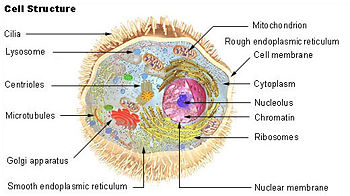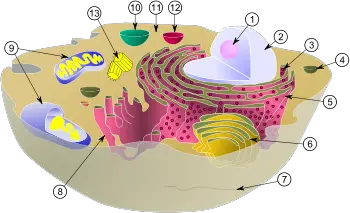Difference between revisions of "Lysosome" - New World Encyclopedia
Rick Swarts (talk | contribs) |
Rick Swarts (talk | contribs) |
||
| Line 44: | Line 44: | ||
==Functions== | ==Functions== | ||
| − | + | Lysosomes function in the digestion of [[macromolecule]]s from [[phagocytosis]] (ingestion of other dying cells or larger extracellular material), [[endocytosis]] (where [[Receptor (biochemistry)|receptor protein]]s are recycled from the cell surface), and [[autophagy]] (wherein old or unneeded organelles or proteins, or microbes that have invaded the cytoplasm are delivered to the lysosome). Autophagy may also lead to [[autophagy|autophagic cell death]], a form of [[programmed cell death|programmed self-destruction]], or [[autolysis]], of the cell, which means that the cell is digesting itself through the action of its own enzymes. Autolysis in initiated by the lysosomes releasing the [[digestive enzyme]]s they contain out into the [[cytoplasm]]; the cell then, in effect, starts to digests itself. | |
| − | Other functions include digesting foreign bacteria (or other forms of waste) that invade a cell and helping repair damage to the [[plasma membrane]] by serving as a membrane patch, sealing the wound. In the past, lysosomes were thought to kill cells that were no longer wanted, such as those in the tails of [[tadpole]]s or in the web from the fingers of a 3- to 6-month-old [[fetus]]. While lysosomes digest some materials in this process, it is actually accomplished through programmed cell death, called [[apoptosis]] | + | Other functions of lysosome include digesting foreign bacteria (or other forms of waste) that invade a cell and helping repair damage to the [[plasma membrane]] by serving as a membrane patch, sealing the wound. In the past, lysosomes were thought to kill cells that were no longer wanted, such as those in the tails of [[tadpole]]s or in the web from the fingers of a 3- to 6-month-old [[fetus]]. While lysosomes digest some materials in this process, it is actually accomplished through programmed cell death, called [[apoptosis]] (Mader 2007). |
| − | |||
| − | |||
| − | |||
| − | |||
| − | |||
==Clinical relevance== | ==Clinical relevance== | ||
| Line 73: | Line 68: | ||
Bainton, D. 1981. The discovery of lysosomes. ''J. Cell Biology'' 91:66s-76s. | Bainton, D. 1981. The discovery of lysosomes. ''J. Cell Biology'' 91:66s-76s. | ||
| + | |||
| + | * Mader, S. 2007. http://users.rcn.com/jkimball.ma.ultranet/BiologyPages/L/Lysosomes.html</ref><ref>Mader, Sylvia. (2007). Biology 9th ed. McGraw Hill. New York. ISBN 978-0072464634</ref> | ||
{{organelles}} | {{organelles}} | ||
Revision as of 21:45, 6 July 2008

Lysosome is an organelle of eukaryotic cells that contains hydrolytic enzymes active under acidic conditions and involved in intracellular digestion. This membrane-bound sub-cellular structure contains a unique collection of about 40 hydrolytic enzymes, including proteases, nucleases, lipases, glycosidases, phospholipases, phosphatases, and sulfates, all of which are acid hydrolases, optimally active near pH 5 (Alberts et al. 1989). They digest excess or worn-out organelles, food particles, and engulfed viruses or bacteria. The unique surrounding membrane keeps enzymes out of the cystosol, where they might damage proteins and nucleic acids, although the acid dependence of the enzymes also provides some protection even in leakage given the higher pH (around 7.2) of the cytosol (Alberts et al. 1989).
The name lysosome derives from the Greek words lysis, which means dissolution or destruction, and soma, which means body. They are frequently nicknamed "suicide-bags" or "suicide-sacs" by cell biologists due to their role in autolysis (destruction of a cell through the action of its own enzymes). Lysosomes were discovered by the Belgian cytologist Christian de Duve in 1949.
Overview

(1) nucleolus
(2) nucleus
(3) ribosomes (little dots)
(4) vesicle
(5) rough endoplasmic reticulum (ER)
(6) Golgi apparatus
(7) Cytoskeleton
(8) smooth ER
(9) mitochondria
(10) vacuole
(11) cytoplasm
(12) lysosome
(13) centrioles within centrosome
Lysosomes are membranous bags of hydrolytic enzymes and the principle site of intracellular digestion, being used for controlled digestion of macromolecules (Alberts et al. 1989). Lysomes are created by the addition of hydrolytic enzymes to early endosomes from the Golgi apparatus.
Lysosomes are very diverse in size and shape. This heterogeneity contrasts with the relatively uniform morphology of most cellular organelles, and reflects the wide variety of digestive functions of acid hydrolases, including digestion of phagocytosed microorganisms and intra- and extracellular debris, as well as principal site of cholesterol assimilation from endocytosed serum lipoprotein (Alberts et al. 1989). Lysosomes sometimes are considered a heterogeneous collection of distinct organelles united by having a high amount of hydrolytic enzymes (Alberts et al. 1989).
Lysosomes have a unique surrounding membrane. It contains transport proteins such that the final products of the digestion can pass out of the lysosome and be utilized by the cell or excreted (Alberts et al. 1989). The lysosomal membrane also contains a H+ pump to maintain an acidic pH (Alberts et al. 1989). Thus, the membrane surrounding a lysosome allows the digestive enzymes to work at the 4.5 pH they require. The proteins in the lysosomal membrane generally are unusually highly glycosylated, perhaps helping to protect them from the proteases inside the lysosome (Alberts et al. 1989).
Lysosomes fuse with vacuoles and dispense their enzymes into the vacuoles, digesting their contents.
At pH 4.8, the interior of the lysosomes is more acidic than the cytosol (pH 7.2). The lysosome's single membrane stabilizes the low pH by pumping in protons (H+) from the cytosol via proton pumps and chloride ion channels. The membrane also protects the cytosol, and therefore the rest of the cell, from the degradative enzymes within the lysosome. For this reason, should a lysosome's acid hydrolases leak into the cytosol, their potential to damage the cell will be reduced, because they will not be at their optimum pH.
Enzymes
Some important enzymes in lysosomes include:
- Lipase, which digests lipids
- Carbohydrases, which digest carbohydrates (e.g., sugars)
- Proteases, which digest proteins
- Nucleases, which digest nucleic acids
- phosphoric acid monoesters.
Glycosidases are enzymes involved in the degradation of carbohydrate structures, catalyzing the hydrolysis of the glycosidic linkage to generate two smaller sugars. A phospholipase is an enzyme that converts phospholipids into fatty acids and other lipophilic substances. A phosphatase is an enzyme that removes a phosphate group from its substrate by hydrolyzing phosphoric acid monoesters into a phosphate ion and a molecule with a free hydroxyl group. Sulfatases are esterase enzymes, which remove sulfate from a variety of substrates by hydrolyzing various sulfate esters.
Lysosomal enzymes are synthesized in the cytosol and the endoplasmic reticulum, where they receive a mannose-6-phosphate tag that targets them for transport to the lysosome. Aberrant lysosomal targeting causes inclusion-cell disease, whereby enzymes do not properly reach the lysosome, resulting in accumulation of waste within these organelles.
Functions
Lysosomes function in the digestion of macromolecules from phagocytosis (ingestion of other dying cells or larger extracellular material), endocytosis (where receptor proteins are recycled from the cell surface), and autophagy (wherein old or unneeded organelles or proteins, or microbes that have invaded the cytoplasm are delivered to the lysosome). Autophagy may also lead to autophagic cell death, a form of programmed self-destruction, or autolysis, of the cell, which means that the cell is digesting itself through the action of its own enzymes. Autolysis in initiated by the lysosomes releasing the digestive enzymes they contain out into the cytoplasm; the cell then, in effect, starts to digests itself.
Other functions of lysosome include digesting foreign bacteria (or other forms of waste) that invade a cell and helping repair damage to the plasma membrane by serving as a membrane patch, sealing the wound. In the past, lysosomes were thought to kill cells that were no longer wanted, such as those in the tails of tadpoles or in the web from the fingers of a 3- to 6-month-old fetus. While lysosomes digest some materials in this process, it is actually accomplished through programmed cell death, called apoptosis (Mader 2007).
Clinical relevance
There are a number of illnesses that are caused by the malfunction of the lysosomes or one of their digestive proteins, e.g., Tay-Sachs disease, or Pompe's disease. These are caused by a defective or missing digestive protein, which leads to the accumulation of substrates within the cell, impairing metabolism.
In the broad sense, these can be classified as mucopolysaccharidoses, GM2 gangliosidoses, lipid storage disorders, glycoproteinoses, mucolipidoses, or leukodystrophies.
Additional images
External links
ReferencesISBN links support NWE through referral fees
- This article contains material from the Science Primer published by the NCBI, which, as a US government publication, is in the public domain at http://www.ncbi.nlm.nih.gov/About/disclaimer.html.
- Alberts, B., D. Bray, J. Lewis, M. Raff, K. Roberts, and J. D. Watson. Molecular Biology of the Cell, 2nd edition. New York: Garland Publishing, 1989. ISBN 0824036956.
Bainton, D. 1981. The discovery of lysosomes. J. Cell Biology 91:66s-76s.
- Mader, S. 2007. http://users.rcn.com/jkimball.ma.ultranet/BiologyPages/L/Lysosomes.html</ref>[1]
| Organelles of the cell |
|---|
| Acrosome | Chloroplast | Cilium/Flagellum | Centriole | Endoplasmic reticulum | Golgi apparatus | Lysosome | Melanosome | Mitochondrion | Myofibril | Nucleus | Parenthesome | Peroxisome | Plastid | Ribosome | Vacuole | Vesicle |
Credits
New World Encyclopedia writers and editors rewrote and completed the Wikipedia article in accordance with New World Encyclopedia standards. This article abides by terms of the Creative Commons CC-by-sa 3.0 License (CC-by-sa), which may be used and disseminated with proper attribution. Credit is due under the terms of this license that can reference both the New World Encyclopedia contributors and the selfless volunteer contributors of the Wikimedia Foundation. To cite this article click here for a list of acceptable citing formats.The history of earlier contributions by wikipedians is accessible to researchers here:
- Lysosome history
- Autolysis_(biology) history
- Glycoside_hydrolase history
- Phospholipase history
- Phosphatase history
- Sulfatase history
The history of this article since it was imported to New World Encyclopedia:
Note: Some restrictions may apply to use of individual images which are separately licensed.
- ↑ Mader, Sylvia. (2007). Biology 9th ed. McGraw Hill. New York. ISBN 978-0072464634
